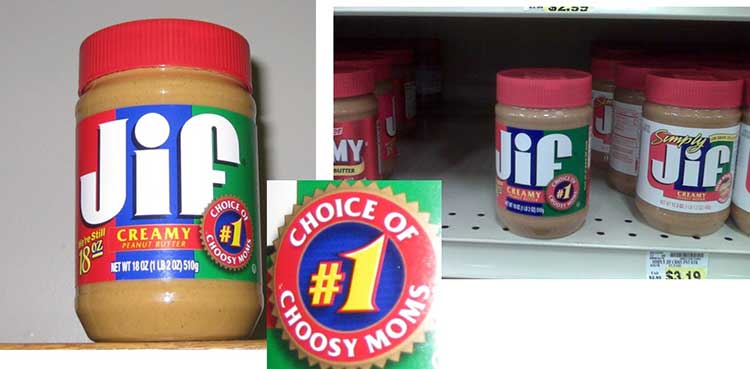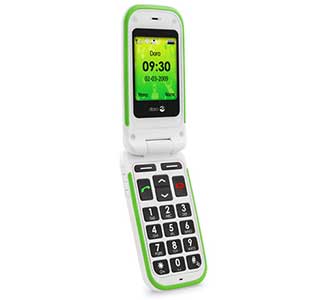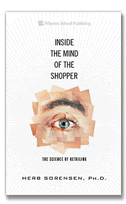How to sell the few?
In the last issue of the Views we discussed in some detail the proper role of the long tail in attracting shoppers to the store, providing support for the big head and as a competitive imperative - not optional for survival in the real world of competition. But the dominant source of sales success in any store will be the mass of shoppers, and their preponderant interest in the big head! Here we will deal with specifically the question of how to sell the few, the winning big head, in the presence of the overwhelming tens of thousands in the long tail.
How to sell the few? The question itself goes a long way toward answering itself, by specifying "the few."
To illustrate, the reason that end-caps (end of aisle displays) sell so effectively is that they make a distinct offer: as the shopper sees it, a display with an open aisle on either side of it, and only a few items on it! The offer on the end-cap is clear and distinctive. (And as some retailers have found, it can be just as effective without the price marked down as it is with a cut-price.) Move around the end-cap into the aisle, and you face an indiscriminate display on both walls of the aisle, of maybe 5000 items. The end-cap is the antithesis of the clutter in the aisle. The end-cap IS clarity of an offer in the store. (But it is not the only way to do that.)
The blinking VCR in the grocery aisle!
In attempting to get inside the mind of the selling process, I find it helpful to rely on examples of real world super-salesmen, and others' perceptive analysis of it. Malcolm Gladwell is a very perceptive, analytical thinker about the human condition, often including commercial issues. In his essay on a family of super-salesmen who achieved very nearly unbelievable levels of sales of household appliances, over several generations, he illustrates some of the features that are sorely missing in the self-service retail world. The material and commentary below is provided so that marketers may judge for themselves how deficient what passes for "selling" in the self-service retailing world, really is - in relationship to the shoppers. (Read Gladwell's whole book, What the Dog Saw.)
"Thirty years ago, the videocassette recorder came on the market, and it was a disruptive product, too: it was supposed to make it possible to tape a television show so that no one would ever again be chained to the prime-time schedule. Yet, as ubiquitous as the VCR became, it was seldom put to that purpose. That's because the VCR was never pitched [sold]: no one ever explained the gadget to American consumers-not once or twice but three or four times-and no one showed them exactly how it worked or how it would fit into their routine, and no pair of hands guided them through every step of the process. All the VCR-makers did was hand over the box with a smile and a pat on the back, tossing in an instruction manual for good measure. Any pitchman [salesman] could have told you that wasn't going to do it."
This is an insightful perspective on both the VCR, and the way in which it was sold to shoppers. After showing us how a real salesman sells an appliance, Gladwell will return to the VCR, and how Ron Popeil might modify and sell it. Here's the super-salesman at work:
"Make the product the star."
"This was a lesson Ron Popeil never forgot. In his infomercial for the Showtime Rotisserie, he opens... with a series of shots of meat and poultry, glistening almost obscenely as they rotate in the Showtime. A voiceover describes each shot: a 'delicious six-pound chicken,' a 'succulent whole duckling,' a 'mouthwatering pork-loin roast...' [Ron] bangs a hammer against the door of the Showtime, to demonstrate its strength. He deftly trusses a chicken, impales it on the patented two-pronged Showtime spit rod, and puts it into the oven... All the time,... [he is] leading viewers through every step: 'All I'm going to do here is slide it through like this. It goes in very easily... Raise up my glass door here. I'll turn it to a little over an hour... Just set it and forget it.'"
Let's see how this can relate to selling in the aisles of supermarkets, super-centers, hypermarkets or other self-service establishments, because the principles apply to all. This is especially important because you can't have "Ron Popeil," personally, in the aisle with the shopper. Also, bear in mind that if you could have "Ron Popeil" in a few aisles, you could certainly increase the sales of those few items by at least an order of magnitude (10X) and possible by several orders of magnitude. We'll go over the significance of these large increases shortly.
The first thing to notice is that you simply can't sell, in this way, 40,000 items in the store, 2,000 items in the category, or 20 items in your brand line-up. But you can approximate this selling process for one or a few items in the brand or category, and probably a few dozen across the store. But why would it be worth it to focus on, and make a lot of effort on behalf of just those few? The answer to that question is because those few represent the greatest opportunity for accelerating sales and profits. They express, massively, the in-most desires and needs of the crowd of shoppers.
So, stay with me on this. It is a matter of easily verified records (transaction-logs from the scanner) that as few as 300 items out of 40,000 in the store contribute 25% of total store sales. Suppose we select 60 of those items, across the store and categories, and give them our "Ron Popeil" treatment (we'll discuss what that might be soon.) Suppose that we are able to not increase the sales of those by 10X, but more modestly, we will simply double the sales, on average, of those 60 items. Those 60 are contributing 5% of total store sales, and doubling the sales of those 60 (5% of sales) will essentially give you another 5% of total store sales. Sorry for all the numbers, but you'll be very happy for the extra sales and profits coming from those numbers.
The reality is that we have done this for the total store, but are equally confident that it will work for a category or brand, and have identified brand examples that are leveraging the principle... but always with one serious compromise. Whether retailer or brand supplier, whenever anyone identifies a "Ron Popeil" way of selling something, they always (in my observation) cut "Ron" off at the knees by trying to get him to sell, not a single item (or a few) but everything they want to sell. In this way the effectiveness is destroyed, because you can't spread that selling juice widely. It has to be focused. And in order to get maximum effectiveness, it has to be focused on where maximum sales can be obtained. And guess what? MAXIMUM sales can be obtained from what is already getting a lot of sales. Get OVER what you want to sell. Become a salesman, and SELL what the shoppers mostly want to buy. My fear for YOU, is that you may never catch on to the profound lesson in these few paragraphs, but some competitor may. :-)
Before concluding with some tips on being "Ron Popeil" in the aisles of the supermarket, let's see how Ron might have managed the blinking VCR:
If Ron had been the one to introduce the VCR, in other words, he would not simply have sold it in an infomercial. He would also have changed the VCR itself, so that it made sense in an infomercial. The clock, for example, wouldn't be digital. (The haplessly blinking unset clock has, of course, become a symbol of frustration.) The tape wouldn't be inserted behind a hidden door - it would be out in plain view, just like the chicken in the rotisserie, so that if it was recording you could see the spools turn. The controls wouldn't be discreet buttons; they would be large, and they would make a reassuring click as they were pushed up and down, and each step of the taping process would be identified with a big, obvious numeral so that you could set it and forget it. And would it be a slender black, low-profile box? Of course not. Ours is a culture in which the term "black box" is synonymous with incomprehensibility. Ron's VCR would be in red-and-white plastic, both opaque and translucent swirl, or maybe 364 Alcoa aluminum, painted in some bold primary color, and it would sit on top of the television, not below it, so that when your neighbor or your friend came over he would spot it immediately and say, "Wow, you have one of those Ronco Tape-O-Matics!"
If you find this short dissertation by Malcolm Gladwell to be scarcely relevant to selling toothpaste in a hypermarket, stay tuned as we illustrate one way to move personal selling skills into the self-service world. Eventually this will be done through iPhones and other personal "selling" devices, which will allow the consummate online selling skills of an Amazon to be deployed right in the aisle. (The Convergence of Online, Mobile and Bricks-and-mortar - COMB - retailing.) However, we can reap many of the advantages of personal selling, without the technology, in stores around the world, right now!
So here is an example of "Ron Popeil" in the aisle of the supermarket.

On the left you see the actual package with the "Popeil-like" indicia (center): "#1 Choice of Choosy Moms." This is one of the most excellent "Popeilisms" I have ever seen.
Think about it, as a shopper: So this is #1 for choosy mom's? Then perfect for me, and into the basket. Not only is the #1 never excelled - it's what #1 means - but this is using the very best of social marketing, "choosy moms," a group whose choices I want to emulate. Come to think of it, I'll just go with them. I don't need to make a choice, my autopilot can handle this one, so now it's a habit. (See Habit: The 95% of Behavior Marketers Ignore by Neale Martin.) Bear in mind that making choices is a psychically costly activity. Of course, sometimes people enjoy shopping, but way too many marketers have their heads in the clouds, thinking that people really love to shop, and buy their stuff. Rather, you are winning when they are buying you on autopilot, habitually - buying your products without thinking about it. Now, THAT's a pleasure! (For both you and the shopper.)
The illustration above is a well executed selling of Jif. But there are two further points to note about this execution. In the photo on the right, notice that there is only one jar of this product left on the shelf. (This is not a staged photo.) The store is one sale away from an out-of-stock (OOS.) Of course, OOS accounts for a lot of missed sales in stores, but this is what we call an "A" class business problem - running out of product. It proves that your "Ron Popeil," your salesman is working! Of course you can expect a lot more OOS problems when you start really selling stuff. In fact, this will be a reason to get down on your knees and thank the good Lord for OOS!
That's all to the good, but notice the shelf to the right of our winner. Sure enough, the marketer has slipped indicia similar to the one on the #1 product, hoping to sell it too! "Ron Popeil" would never lose focus this way on what he wants to sell, #1 only. The reality is that you are trying to sneak in some sales on the shopper's autopilot by having the product next door slip in, in a "me too, over here," mode. It obviously wasn't too effective, because the shelf is full - unsold product. This is OK for that product on the right, but not for #1, which is having its message diluted by asking "Ron" to help with selling this one, too. This dilution of the big head (#1) by the long tail is the most irrational, anti-shopper strategy, that hordes of non-selling marketers, both retailers and their suppliers have nearly uniformly adopted over the past one hundred years.
Before leaving the "blinking VCR on the grocery shelves," let me explain the choice of words. The reason the VCR has a blinking, unset clock on it, is that it has at least this one feature that is not absolutely necessary - at least for playing back a VCR tape - and it is not intuitive to VCR users how to set the clock. Technology devices are as plagued with proliferation of features as are stores with proliferation of products. It really is a parallel problem, because for every feature software adds, or hardware incorporates, there MUST be a path to access that feature. If that path is not simple and intuitive, that feature may as well be non-existent. It is even worse if the multitude of features so obscure what the main purpose is that a user cannot figure out how to use the device. Smart phones are proliferating features and apps at a horrendous rate. One response to this has been ultra simple cell phones that basically have no features other than dialing numbers to make a call, and answering when the simple phone is called.

Proliferation of products that are rarely purchased is an exact parallel to the proliferation of rarely used features. The principles of simplifying access to what is heavily used - the big head of features - are much the same as simplifying shopping for the big head.
Rather than being satisfied with accelerating sales of mostly what shoppers want to buy, most self-service retailers are willing to compromise these sales in hopes of selling something demonstrably less desirable to the shoppers. There is nothing wrong with having those long tail items within easy eyesight, even adjacent to the big head. But create focus on the big head - help the shopper's autopilot. Shoppers (the minority) who prefer one of the long tail items, are not disadvantaged because you provide better assistance to the great majority who want the big head.
The stresses of the global recession have created more interest in how to accelerate sales and profits. My own suggestion is to pay closer attention to what shoppers actually do (it's mostly what they want to do,) and help them to do it faster, so they can do more of it. Somebody is buying YOUR products right now. Help them to do it more efficiently, and they will do more of it.
Here's to GREAT "Shopping!"
Your friend, Herb Sorensen



